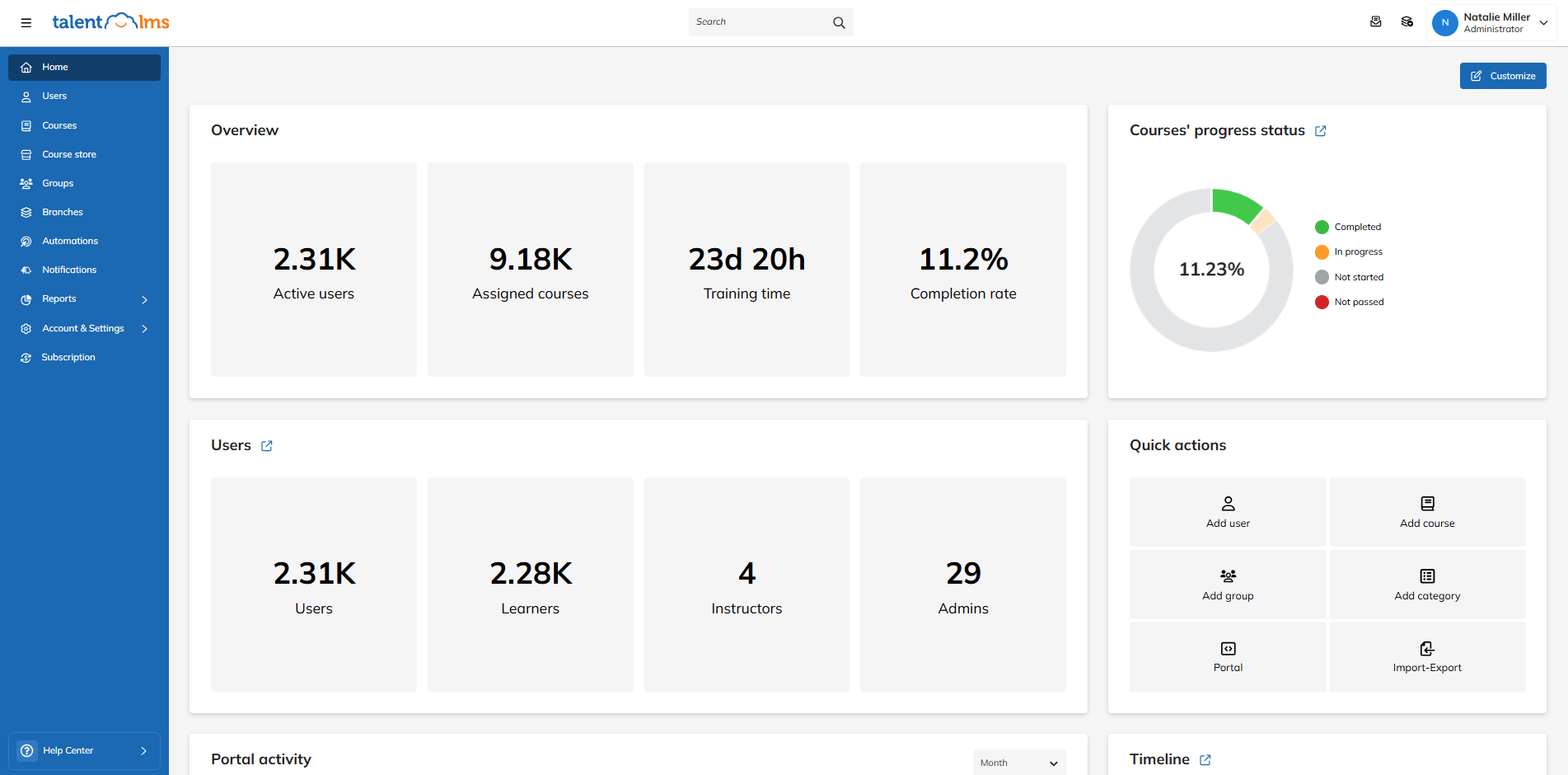- What is hybrid learning?
- Is hybrid learning the same as online learning?
- What’s the difference between hybrid learning and blended learning?
- The hybrid learning model in a hybrid workplace
- An example of hybrid learning
- What are the benefits of hybrid learning?
- How to create a successful hybrid learning program
- Supercharge your teams with hybrid learning
In the post-pandemic world, the way we work has been completely transformed. Whether it’s remote, hybrid, or in-office, businesses of all sizes are exploring new work models to stay competitive. But this shift isn’t just about where we work. It’s about how we learn, too. As more companies embrace flexible work environments, L&D teams are turning to innovative solutions to train their people, like hybrid learning.
Let’s dive into how the hybrid learning model in the workplace is a powerful transformation tactic and why it’s the future of employee development.
What is hybrid learning?
Let’s look first at the hybrid learning definition. The hybrid learning model is an educational model that blends traditional, in-person training with online learning. It’s not exactly like pure online education, where all learning takes place remotely. Or like traditional learning which requires full physical attendance. Hybrid learning allows learners to participate in classes both in person and online.
This is a particularly beneficial learning model for matching various learning styles and offering flexibility for learners and instructors alike.
Is hybrid learning the same as online learning?
Hybrid learning isn’t the same as online learning.
Both include digital elements but differ significantly in structure and delivery. Let’s see in detail how:
Online learning takes place only on digital platforms. All interactions, assessments, and learning content are delivered via the Internet.
A hybrid learning environment combines online and face-to-face learning. Learners may attend some classes in person, and complete others online.
What’s the difference between hybrid learning and blended learning?
It’s time to dive into hybrid learning vs blended learning. Hybrid and blended learning are often used interchangeably. But they have distinct differences.
Hybrid learning involves simultaneous in-person and online participation in training. Some learners attend the training in a traditional classroom setting, while others join the same training online through a web conferencing tool.
For hybrid training to be effective, instructors must ensure both groups participate equally by using appropriate video conferencing tools, addressing technical challenges, and preparing thoroughly in advance.
Blended learning combines traditional, in-person learning and instructor-led training with online, self-paced content.
This method offers both synchronous, in-person sessions for direct interaction and asynchronous learning elements, allowing learners to progress at their own pace.
The hybrid learning model in a hybrid workplace
Big and small businesses are reimagining how their teams will work in the post-pandemic world. Gallup recently found that about 54% of employees who can work remotely expect to split their time between home and the office, while 37% plan to work entirely from home.
So, as this shift to hybrid and remote work has become the new normal, many companies are turning to their L&D teams to support these flexible work models. Interestingly, hybrid workplaces don’t have to choose hybrid learning over other types of training. In fact, hybrid workplaces can employ a variety of learning models, including hybrid, to boost employee development.
In a hybrid workplace, organizations can turn to hybrid learning to ensure that everyone, regardless of location, has access to high-quality training. This approach supports continuous learning and assists in bridging the gap between remote and in-office employees. Fostering, as a result, a more inclusive and cohesive work environment.
An example of hybrid learning
Let’s check out what a hybrid learning environment could look like with a fictional example.
Imagine a company, TechStarters, that’s recently adopted a hybrid work model. The company has a diverse workforce, spread across different locations. Some employees work remotely, and others come into the office a few days a week.
To ensure that everyone receives the same level of training and development, TechStarters implements a hybrid program. For instance, the company launches a new training course on cybersecurity awareness, a critical topic for their industry. The course will be designed with the hybrid learning experience in mind using the following structure:
- In-person sessions: Employees are invited to attend a series of in-person workshops at the office. These sessions are interactive, allowing people to engage in in-person discussions, ask questions, and participate in hands-on activities.
- Online modules: For those who won’t be able to attend in person or for those who just prefer to learn at their own pace, the same content will be made available through online training software. The online activities will include video lectures, interactive quizzes, virtual simulations, and discussion boards for information exchange between peers.
- Virtual Q&A sessions: It’s important to make sure that all employees (whether in-person or online) have the chance to ask clarifying questions and engage with the instructor. Virtual Q&A sessions will be open to all participants, providing a platform for discussion and further learning.
What are the benefits of hybrid learning?
Hybrid learning models bring numerous benefits to both employees and businesses. Let’s break down the benefits into two categories and explore them in further detail.
Benefits for employees
Flexibility
One of the most important advantages of the hybrid learning model is the flexibility it offers. Employees have the opportunity to choose whether to attend in-person sessions or complete online activities at their own pace, depending on their location or schedule. The flexibility of hybrid learning models is valuable for people with varying schedules or those balancing work and personal commitments.
Heightened learning experience
Hybrid learning models cater to different learning styles. Some learners prefer face-to-face instruction, while others find online learning activities better for their needs. By offering both options with hybrid learning, all employees engage with the course materials in a way that suits them best.
Gary Cookson discusses all about hybrid learning and the hybrid workforce on Training teams in a hybrid world, from TalentLMS’ podcast series, Keep it Simple. More specifically, he stresses the importance of making learning engaging.
This means that hybrid learning allows content to be presented in bite-sized, engaging formats that suit both in-person and online learners, keeping them engaged and motivated.
Increased accessibility
For employees unable to attend in-person, traditional training due to location or time constraints, hybrid courses for remote learning are the best alternative. This inclusivity allows all employees to have equal opportunities for professional development, no matter where they are located.
Continuous learning opportunities
Hybrid learning encourages a culture of continuous learning. Employees have constant access to online resources, meaning they can revisit learning materials, stay updated on new trends and developments, and continue to boost their skills. Even after the formal training sessions have been completed.
Cookson claims “The problem (with learning) is not with the way things are being accessed, i.e., through a screen or face-to-face. The problem is in how it’s being delivered. So, there is a lack of engagement. The problem is potentially boring content.” Meaning that learning opportunities don’t always have to be formal or dull. Even nanolearning can do wonders as a refresher for learners. But the content should be engaging and interactive.
Benefits for employers and HR teams
Cost-effective training
Hybrid learning is an inexpensive solution for training employees. As it combines online and in-person training, it allows companies to reduce travel and accommodation costs associated with traditional training programs. Plus, online training modules can be reused and updated as needed, further reducing costs.
Scalability
Whether a company has 50 employees or 5,000, hybrid learning programs can be easily expanded to meet the needs of a growing workforce. The high scalability of hybrid learning benefits businesses that are rapidly growing or those that have a dispersed or global workforce.
Higher employee engagement
A variety of learning mediums leads to increased employee engagement. Why? When people have the flexibility to choose how they learn, they are more likely to stay motivated and invested in their development. This, in turn, leads to higher job satisfaction and retention rates.
Cookson highlights this shift, noting, “We (L&D professionals) are no longer the sage on the stage, the font of all knowledge… We’re somebody who facilitates learning and, more importantly, facilitates performance.” In this new paradigm, the focus is on supporting employee growth through facilitation rather than just delivering information.
Data-driven insights
Hybrid learning happens on platforms like LMSs, which often have built-in analytics tools. These tools allow HR teams to track employee progress, engagement, and performance. With these insights, HR teams can then identify areas where people may need additional support or tailor training programs to better meet learners’ needs.
How to create a successful hybrid learning program
There’s no such thing as a successful hybrid learning program without careful planning and consideration. The good news is that we’ve collected key strategies that ensure your hybrid learning is both effective and engaging:
Invest in a powerful LMS
Your LMS is your key tool for managing hybrid learning programs. It allows you to organize and deliver training content, track employee progress, and provide a centralized hub for all training material. The LMS you choose should be user-friendly, scalable, and have the ability to integrate with other tools and software used by your organization.
Create a culture of ongoing learning
Hybrid learning is just a part of a broader culture of continuous learning within your organization. To encourage employees to take ownership of their own learning journey, provide them with the resources and support they need to succeed. Meaning, offering access to online training courses, setting aside time for learning during the workday, and recognizing and rewarding people who actively engage in their development.
Collect feedback
Never skip gathering feedback from employees. It’s crucial for refining and improving your hybrid learning program. Surveys, focus groups, and 1:1 interviews are necessary to understand what’s working well and where there’s room for improvement. Then, act on this feedback to make adjustments that enhance the learning experience for all.
Provide the right support
Support is necessary for any successful learning program and in all learning environments. Let alone the hybrid learning model. Make sure that employees have access to the resources they need. Be it tech support for navigating the LMS, access to extra learning material, or opportunities to connect with instructors and peers for guidance and collaboration.
Keep up to date with new learning tech
L&D is constantly evolving with new technologies. It’s essential to stay informed about the latest trends and tools in hybrid learning. And be open to incorporating them to make your online learning program more interactive and engaging. For instance, you should try using VR, simulations, gamification, or AI-powered personalized learning paths.
Consider accessibility
Cookson highlights, “You can’t treat everybody the same and expect everybody to behave and perform the same. Which is also true about learning and training.”
Accessibility is critical when discussing hybrid learning programs. All online content must be accessible to employees with disabilities. For instance, you might need screen readers, captions, or other assistive technologies. In addition, think about the different levels of digital literacy among your employees. Provide training and support to ensure everyone can effectively engage with the online parts of your program.
Supercharge your teams with hybrid learning
The hybrid learning model isn’t just a trend. It’s the future of employee development.
By combining the best of in-person and online training, it’s possible to create dynamic, flexible, and engaging learning environments for the modern workforce. Whether you’re looking to boost productivity, engagement, or simply keep your people ahead of the curve, hybrid learning is your secret weapon.
Unlock your team’s full potential and drive your organization’s success with hybrid learning for all.







